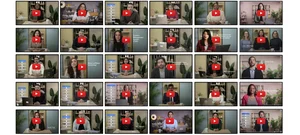News Lab in 2017: working with news organizations to address industry challenges
Editor’s Note: This week we’re looking at the ways the Google News Lab is working with news organizations to build the future of journalism. This is the first in a four-part series.
2017 was a critical time for both the news and technology industries. The battle against misinformation, rapidly-changing business models for news organizations and fundamental questions about the relationship between journalism and technology have made Google’s role in supporting quality journalism as important as it’s ever been. We started the Google News Lab in 2015 to work alongside newsrooms to navigate those issues and build a stronger future for news.
No single technology, platform or partnership will solve every challenge the news industry faces, so we’ve focused on using our resources and technology to help newsrooms and journalists try new things. Three of the biggest challenges we focused on in 2017 were trust and misinformation, inclusive storytelling and local news. Today, we’ll provide detail on how we approached those challenges—and to ensure we’re tackling the right ones in the future, we’d love to hear feedback and new ideas.
Trust and misinformation
Though it's been a focus since we founded the News Lab, curbing the spread of misinformation and helping people understand what content they can trust has become even more important this year, in light of events across the world. Our efforts to fight misinformation focus on three key groups—platforms, newsrooms and consumers.
Platforms: Google has launched a number of features to prevent the spread of misinformation on our platforms, and News Lab has built partnerships to strengthen those efforts.
- The Trust Project worked with 75 news organizations to produce eight trust indicators that newsrooms can add to their content to help people distinguish between reliable and inaccurate content.
- We're working with organizations like World Wide Web Consortium (W3C) and Schema.org to help publishers develop and communicate “signals” that platforms can use to identify quality journalism. We also introduced a tag on Google News and Search that helps consumers understand the validity of a newsworthy claim by providing information on the claim, who made it and an assessment of whether it’s factual. And we partnered with the International Fact Checking Network to support and grow the network of fact-checkers in the world with technology and training. Our goal is to double the number of fact-checking institutions in the network by 2019.
Newsrooms: Discovering and debunking misinformation is a daunting task for any newsroom, but we’re encouraged by a new generation of organizations developing methods to meet this challenge.
- We helped start the First Draft coalition of digital media verification experts to combine efforts and share best practices with newsrooms everywhere. This year, they produced “A Field Guide to Fake News,” a playbook on how newsrooms can fight misinformation. Their recent report “Information Disorder” offers an excellent approach for understanding and grappling with misinformation.
- Along with hundreds of news organizations around the world, we created pop-up newsrooms to discover and debunk fake news stories and provide readers with accurate information during the U.K., French and German elections. Early research shows that this is working, and the effort in France received an ONA award for helping build a blueprint for verification around key moments. We plan to continue these experiments in 2018, and we’re developing tools and training on how our products can help in this area.


Consumers: In an age of information overload, we need to do more to help news consumers distinguish fact from fiction. Recent research out of Stanford suggests that news consumers—even young, tech-savvy students—struggle with parsing the difference between accurate and false claims. To help people develop skills to navigate news in a digital age, we launched a news literacy program in Canada, which we’re looking to expand in the coming year. We’re also working with our product teams to ensure our platforms help news consumers understand how to judge the credibility of content online, building on features like the publisher knowledge panel.
Inclusive storytelling
In order for newsrooms to serve their readers and uncover the most important stories in their communities, they need to reflect the diversity of their markets. But this remains a challenge: in a survey we produced with the American Society of News Editors, we found that diversity in U.S. newsrooms hasn’t improved much over time. For instance, men still make up 63 percent of newsrooms in the U.S.
This visualization from Polygraph shows how U.S. newsrooms have changed since 2001, according to ASNE’s survey data.

So we’ve focused our energy on partnerships to empower journalists from a diverse range of backgrounds and communities. We’re working with Maynard Institute to support 200 people of color in media, and we backed the Street School in France and the Hamburg media school in Germany to train young journalists from underprivileged backgrounds. We’ve also created fellowships and programs to give diverse journalists new opportunities, with groups like NCTJ Journalism Diversity Fund and Neue Deutsche Medienmacher.
We also think technology can play an important role in understanding bias in news. In 2016 Google.org, USC and the Geena Davis Institute used machine learning to create a tool that identified gender distribution in Hollywood. We’re building on this work to explore how newsrooms can apply the same technology to better understand representation in news coverage.
Local news
Local newsrooms have been hit hard by the shift to digital, with revenue pressures causing local newsrooms to shrink—or worse, close down. Through a partnership with the Society for Professional Journalists, we’ve trained more than 9,500 local reporters across America on essential skills, from multimedia storytelling to safety and security, in the last year. And our partnership with the Center for Investigative Reporting’s Reveal Labs gave local journalists in Mississippi and New Jersey the resources to experiment on new models for investigative reporting.
We’re looking at new models for strengthening the local news ecosystem, through initiatives like Report for America, which will place a thousand journalists in local newsrooms in the next five years. Over the next six months, we’ll pilot the program in 12 local newsrooms in areas underserved by local news media.

Feedback from journalists and others in the industry is important to our efforts. We’d love your feedback, which you can share through this form. In our next post, we’ll talk about how we’re helping news organizations navigate new technologies—like virtual reality, data visualizations and machine learning—in their newsrooms.







